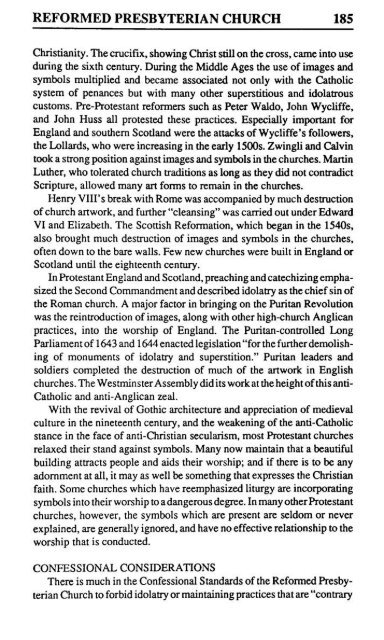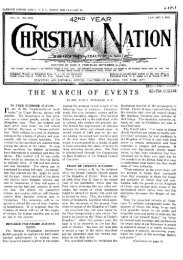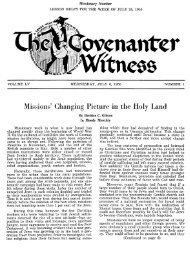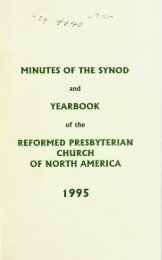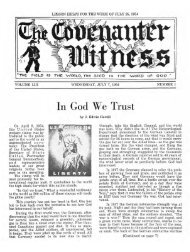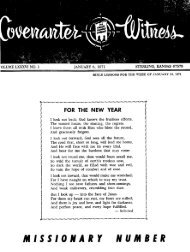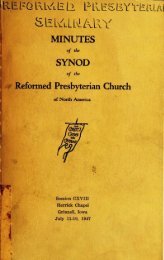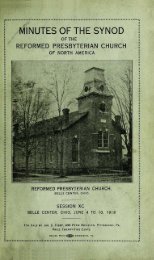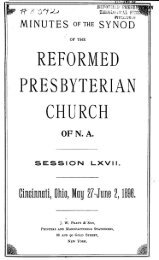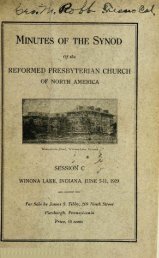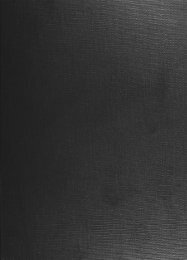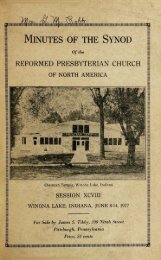Reformed Presbyterian Minutes of Synod 1993
Reformed Presbyterian Minutes of Synod 1993
Reformed Presbyterian Minutes of Synod 1993
- No tags were found...
Create successful ePaper yourself
Turn your PDF publications into a flip-book with our unique Google optimized e-Paper software.
REFORMED PRESBYTERIAN CHURCH 185Christianity. The crucifix, showing Christ stiU on the cross, came intoduring the sixth century. During the Middle Ages the use <strong>of</strong> images andsymbols multiplied and became associated not only with the Catholicsystem <strong>of</strong> penances but with many other superstitious and idoladouscustoms. Pre-Protestant reformers such as Peter Waldo, John Wycliffe,and John Huss all protested these practices. Especially important forEngland and southern Scotland were the attacks <strong>of</strong> Wycliffe's followers,the Lollards, who were increasing in the early 1500s. Zwingli and Calvintook a sdong position against images and symbols in the churches. MartinLuther, who tolerated church daditions as long as they did not condadictScripture, allowed many art forms to remain in the churches.Henry VIII's break with Rome was accompanied by much destmction<strong>of</strong> church artwork, and further "cleansing" was carried out under EdwardVI and Elizabeth. The Scottish Reformation, which began in the 1540s,also brought much destruction <strong>of</strong> images and symbols in the churches,<strong>of</strong>ten down to the bare walls. Few new churches were built in England orScotland until the eighteenth century.In Protestant England and Scotland, preaching and catechizing emphasizedthe Second Commandment and described idolatry as the chief sin <strong>of</strong>the Roman church. A major factor in bringing on the Puritan Revolutionwas the reindoduction <strong>of</strong> images, along with other high-church Anglicanpractices, into the worship <strong>of</strong> England. The Puritan-condolled LongParliament <strong>of</strong> 1643 and 1644 enacted legislation "for the further demolishing<strong>of</strong> monuments <strong>of</strong> idolatry and superstition." Puritan leaders andsoldiers completed the destmction <strong>of</strong> much <strong>of</strong> the artwork in Englishchurches. The Westminster Assembly did its work at the height <strong>of</strong> this anti-Catholic and anti-Anglican zeal.With the revival <strong>of</strong> Gothic architecture and appreciation <strong>of</strong> medievalculture in the nineteenth century, and the weakening <strong>of</strong> the anti-Catholicstance in the face <strong>of</strong> anti-Christian secularism, most Protestant churchesrelaxed their stand against symbols. Many now maintain that a beautifulbuilding atdacts people and aids their worship; and if there is to be anyadornment at all, it may as well be something that expresses the Christianfaith. Some churches which have reemphasized liturgy are incorporatingsymbols into their worship to a dangerous degree. In many other Protestantchurches, however, the symbols which are present are seldom or neverexplained, are generally ignored, and have no effective relationship to theworship that is conducted.CONFESSIONAL CONSIDERATIONSThere is much in the Confessional Standards <strong>of</strong> the <strong>Reformed</strong> <strong>Presbyterian</strong>Church to forbid idolatry or maintaining practices that are "contrary


